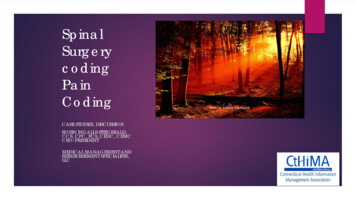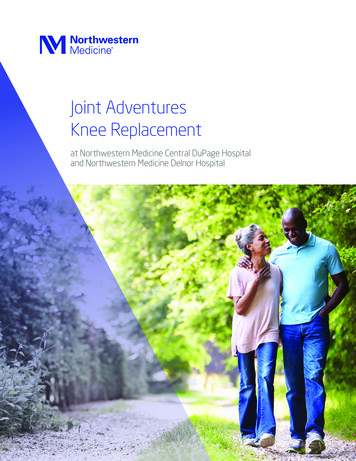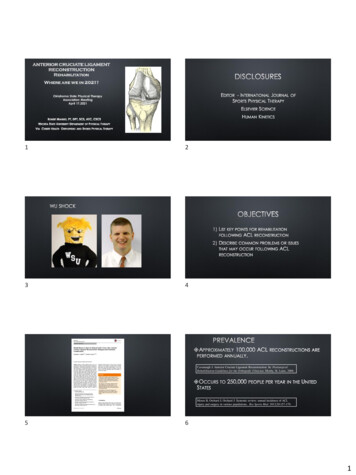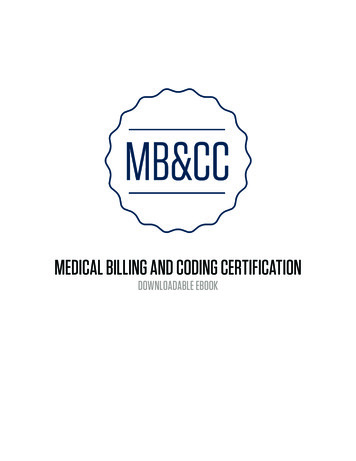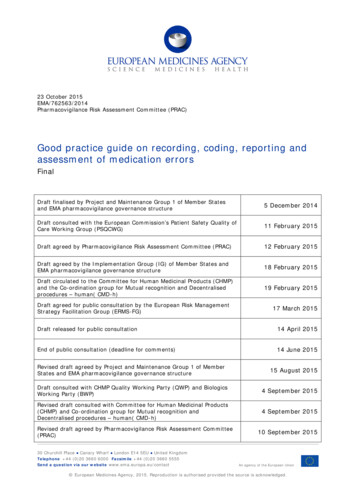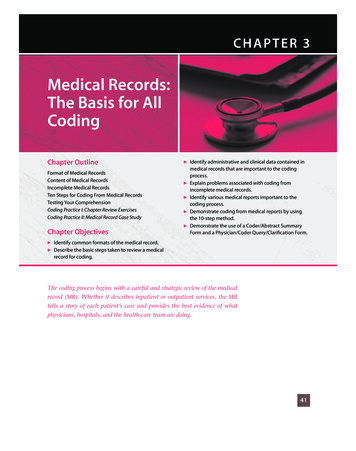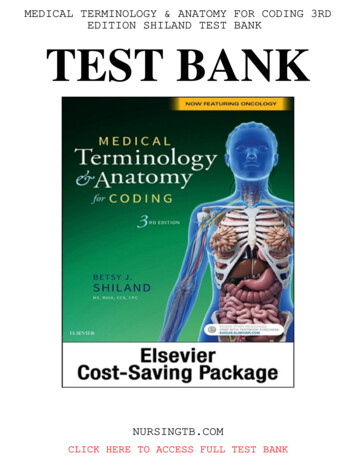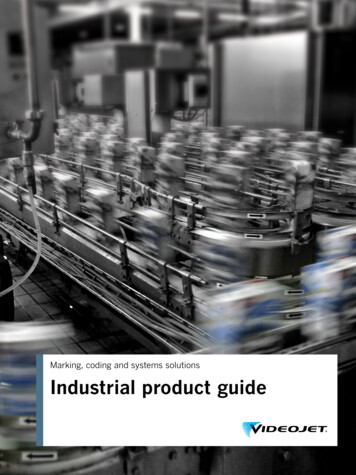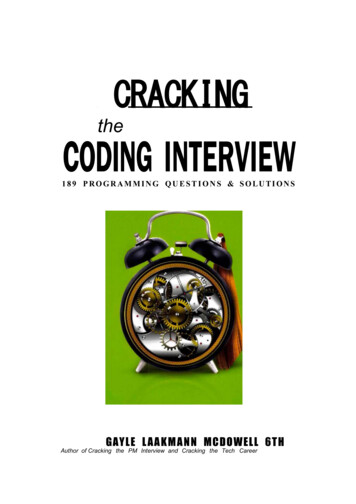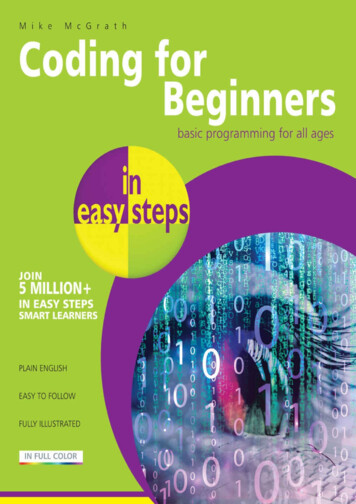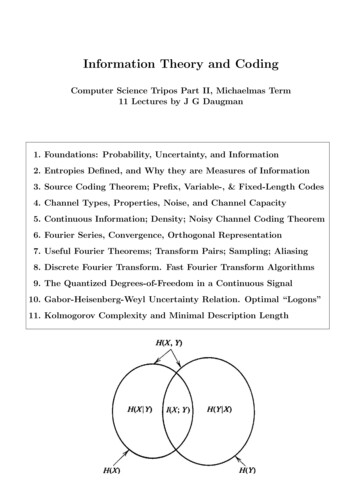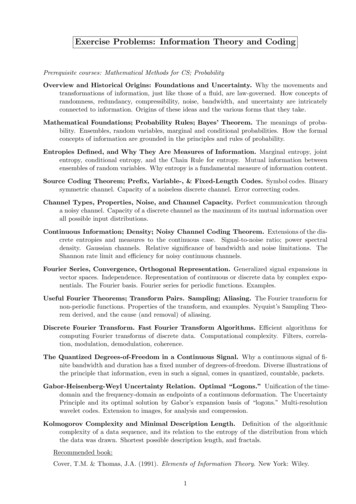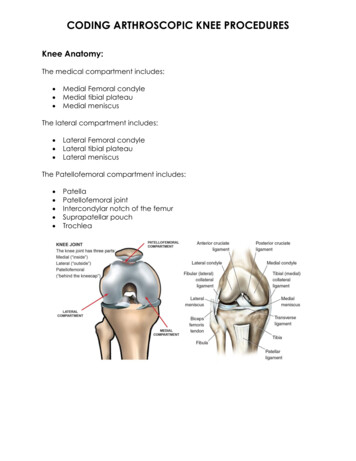
Transcription
CODING ARTHROSCOPIC KNEE PROCEDURESKnee Anatomy:The medical compartment includes: Medial Femoral condyleMedial tibial plateauMedial meniscusThe lateral compartment includes: Lateral Femoral condyleLateral tibial plateauLateral meniscusThe Patellofemoral compartment includes: PatellaPatellofemoral jointIntercondylar notch of the femurSuprapatellar pouchTrochlea
Cartilage of the Knee JointSlippery and flexible, hyaline (articular) cartilage within the knee joint allows, hasless friction than two pieces of glass placed together. This allows the joint tomove with minimal friction in a healthy knee. There are two primary types ofcartilage in the knee: Articular (Hyaline) cartilage. This cartilage covers the bones where theymeet at the knee joint. The end of the femur (condyles) and the back ofthe patella (knee cap). It is simultaneously smooth and strong, allowingbones to move over one another with minimal friction.Meniscus (Fibrocartilage). The menisci are two C-shaped cartilaginousstructures within the knee. The medial (inside) and lateral (outer) menisciact as cushions for weight bearing activities, decreasing the effect ofimpact between the femur and tibia.The articular cartilage and menisci are integral to the proper function of theknee joint. They can be injured in an acutely or gradually through repetitivestresses. The loss of cartilage in the knee is termed arthritis. This can be both
inflammatory, as in rheumatoid arthritis, or primary, as in the case ofosteoarthritis.Tendons, Ligaments, and Other Soft Tissues of the Knee JointThe knee joint relies on a variety of ligaments, tendons, and soft tissue structuresto maintain flexibility, stability, and strength.Ligaments are ropy, fibrous bands of tissue that connect bones to other bones. The Anterior Cruciate Ligament (ACL). The ACL connects the tibia to thefemur and functions to prevent the tibia from sliding forward on the femur.The ACL is commonly injured in sporting activities and rarely injured inisolation.The Posterior Cruciate Ligament (PCL). The PCL also connects the tibia tothe femur. It functions to prevent the tibia from sliding backward on thefemur. The PCL works with the ACL for stabilization of the knee. It iscommonly injured in hyperextension type knee moments.The Lateral Collateral Ligament (LCL). The LCL, which is also known as thefibular collateral ligament, is located on the outside (lateral side) of theknee. It connects the outside, bottom edge of the femur to the outside,top edge of the fibula. The LCL helps stabilize the knee joint by limitingoutward (varus) force across the knee.The Medial Collateral Ligament (MCL). The MCL is located on the inside(medial side) of the knee, connecting the inside, bottom edge of thefemur with the inside, top edge of the tibia. The MCL helps to stabilize theknee by limiting inward (valgus) force across the knee. The MCL works withthe LCL to prevent unwanted side-to-side motion. The MCL is the mostcommonly injured knee ligament.Tendons are flexible tissues that attach muscle to bone. The hamstring tendons. There are three hamstring tendons that cross theknee joint on the back of the knee. Two are on the inside (medial) part ofthe knee attaching to the shin bone (Semimembranosus andSemitendinosus) and one is on the outside (lateral) part of the knee,attaching to the fibula (Biceps femoris).The quadriceps tendon. This tendon is composed of contributions from thefour quadriceps muscles (the vastus lateralis, vastus intermedius, vastusmedialis, and rectus femoris). It attaches the powerful quadriceps musclesto the top part of the patella.The patellar tendon. This tendon (also called patellar ligament) attachesthe bottom part of the patella to the top part of the tibia.A synovial membrane. All of the joints in the body are surrounded by aballoon that holds the joint fluid in. These balloons hold the joint fluid(synovial fluid) in the joint. This fluid is integral to the health of the joint,providing lubrication and delivering nutrients.
Arthroscopy:https://www.youtube.com/watch?v q6-ZE6QWrKAKnee arthroscopy allows the physician to visualize the joint space of the kneeusing a fiberoptic endoscope. (An endoscope is basically a long tube with alens at each end. Endoscopes used to visualize joint spaces are callarthroscopes).This Technology also allows the physician to perform arthroscopic surgery usingInstruments inserted through small incisions, instead of having to perform anopen procedure.Arthroscopic knee surgery usually involved at least two incisions. The first incisionis made on the lateral side of the patellar incision-this is where the arthroscope isinserted. Additional incisions are made, one on the medial side of the patellartendon and other as needed, for the insertion of surgical instruments. Theseincisions are called portals. Saline is infused into the joint space to expand thecavity for easier viewing and instrumentation. The surgeon thoroughly examinesthe joint first; this may require repositioning the leg in order to access all therecesses of the joint cavity. After the diagnostic examination, any problemsnoted may be corrected arthroscopically.CPT Assistant August 2001; page 5:“When both a diagnostic and surgical arthroscopy is performed, thediagnostic arthroscopy is an inclusive component of the surgicalarthroscopy and would not be reported separately.”“Arthroscopic procedures in Separate Compartments: When both adiagnostic and surgical arthroscopy is performed, the diagnosticarthroscopy is an inclusive component of the surgical arthroscopy andwould not be reported separately.”CPT Assistant April 2005; page 14:“From a CPT coding perspective, if debridement or shaving of articularcartilage and meniscectomy are performed in the same compartment ofthe knee, then only code 29881, Arthroscopy, knee, surgical; withmeniscectomy (medial or lateral, including any meniscal shaving), shouldbe reported. However, if debridement or shaving of articular cartilage isperformed in one compartment of the knee and a meniscectomy isperformed in a different compartment of the knee, then codes 29877,Arthroscopy, knee, surgical; debridement/shaving of articular cartilage(chondroplasty), and 29881 should be reported.”HCPCS Code G0289
An important HCPCS code is G0289, Arthroscopy, knee, surgical, for removal ofloose body, debridement/shaving of articular cartilage (chondroplasty) at thetime of other surgical knee arthroscopy in a different compartment of the sameknee. This code is used for Medicare to report the procedure in that description,when performed in a separate compartment of the knee during the sameoperative session. It is not appropriate to use code 29877 even with a modifier.HCPCS code G0289 may be reported in addition to CPT code 29880,Arthroscopy, knee, surgical; with meniscectomy (media AND lateral, includingany meniscal shaving) or CPT code 29881, Arthroscopy, knee, surgical; withmeniscectomy (medial or lateral, including any meniscal shaving)if performed ina separate compartment.Example:29888 – ACL RepairG0289 - Arthroscopy, knee, surgical, for removal of loose body,debridement/shaving of articular cartilage (chondroplasty) at the time of othersurgical knee arthroscopy in a different compartment of the same kneeNote: G0289 is used instead of 29877 because it is in a separate compartmentof the same knee.Example:An arthroscopy with a medial meniscectomy and shaving of the articularcartilage in the lateral compartment is performed on the left knee, commercialcarrier.29881-LT – identifies the excision of the meniscus29877-LT-59 – identifies debridement/shaving of the cartilageAn arthroscopy with a medial meniscectomy and shaving of the articularcartilage in the lateral compartment is performed on the left knee, Medicarepatient.29881-LT – identifies the excision of the meniscusG0289-LT– identifies debridement/shaving of the cartilageWhen appropriate use the -59 modifier with the second procedure. This will letthe payer know that the procedures listed were performed in separatecompartments of the knee.An arthroscopy for medial meniscal repair with at Patellofemoral chondroplasty29882 – Arthroscopic meniscal repair29887-59 – arthroscopic Patellofemoral chondroplasty
If an arthroscopic procedure is performed at one site and an open procedure isperformed at a different site, a modifier should be used to indicate this (-59, RT,LT, etc.). When a procedure is started arthroscopically and converted to anopen procedure, only the most comprehensive service is billed. Exception forthis rule, if the physician performs a therapeutic procedure through the scopebut had planned to do another procedure open, then both procedures may bebilled pending verification with the appropriate guidelines.Example:29876 – Arthroscopy, medical compartment and suprapatellar pouchsynovectomyG0289 - Arthroscopy, knee, surgical, for removal of loose body,debridement/shaving of articular cartilage (chondroplasty) at the time of othersurgical knee arthroscopy in a different compartment of the same kneeNote: G0289 is used instead of 29874 because it is in a separate compartment.Scenario 1Procedures Performed:1. Arthrscopic synovectomy in all three compartments of the left knee2. Loose body removal in the medial compartment of the left knee
CPT Codes:29876 Arthroscopic extensive synovectomy29876 for the extensive synovectomy is the only code reported. G0289 forthe loose body is NOT CODED because the synovectomy was done in thesame compartment as the loose body and therefore it was not in aseparate compartment and is not to be coded.Scenario 2Procedures performed:1. Arthroscopic medical and lateral meniscectomy2. Arthroscopic synovectomy in all three compartments3. Chondroplasty in the medial compartment29880 Arthroscopy medial and lateral meniscectomy
A Chondroplasty is NEVER coded with a meniscectomy regardless of thecompartment. The meniscectomy includes the synovectomy in the codedescription.The synovectomy is global to the 29880 and should only be reported ifdone in two different departments from the meniscectomy. In this case,the meniscectomy was performed in 2 out of the 3 compartments so thatwould be possible because are only 3 compartments.NOTE: What you need to know is that CPT codes 29880 and 29876 are globaland should not be unbundled.Scenario 3Procedures Performed:1. Arthroscopic medial and lateral meniscectomy2. Arthroscopic excision of loose body from the notch in the Patellofemoralcompartment3. Arthroscopic Chondroplasty medial compartmentCPT Codes:29880 Arthroscopy medial and lateral meniscectomyG0289 for the Arthroscopic removal of a loose body in a separate compartment29880 is coded for the medial AND lateral meniscectomySince the loose body removal was done in a separate compartment(patellofemoral), the G0289 is coded.Scenario 4Procedures:1. Medial meniscectomy2. Lateral meniscus repair
29882 Arthroscopy, knee, surgical; with meniscus repair (medial or lateral)29881-59 – Arthroscopy, knee, surgical; with meniscectomy (medial or lateral,including any meniscal shaving) including debridement/shaving of articularcartilage (chondroplasty)Modifier should be utilized to report the 29881 with 29882.Scenario 5Procedures:1. Medial and lateral meniscectomy2. Synovectomy in the patellofemoral compartment3. Loose body removal in the lateral compartment
29875 Arthroscopy, knee, surgical; synovectomy, limited (eg, plica or shelfresection) (separate procedure) Limited synovectomy is defined in CPT as a “separate procedure.” Assuch, do not report 29875 with another arthroscopic procedure in thesame knee. Report it when it’s the only arthroscopic procedureperformed on that knee. Comparts are not recognized for the purpose ofreporting this CPT code.Codes to report are: 29880 is reported because it is the primary procedure.29874 is not coded because it is global to the primary procedure and inthe same compart as was the primary procedure.29875 is not coded because it is global to the primary procedure.
Common Arthroscopic Knee Procedures:29850 - Arthroscopically aided treatment of intercondylar spine(s) and/ortuberosity fracture(s) of the knee, with or without manipulation; without internalor external fixation (includes arthroscopy)29851 - Arthroscopically aided treatment of intercondylar spine(s) and/ortuberosity fracture(s) of the knee, with or without manipulation; with internal orexternal fixation (includes arthroscopy)29855 - Arthroscopically aided treatment of tibial fracture, proximal (plateau);unicondylar, includes internal fixation, when performed (includes arthroscopy)29856 - Arthroscopically aided treatment of tibial fracture, proximal (plateau);bicondylar, includes internal fixation, when performed (includes arthroscopy)29866 - Arthroscopy, knee, surgical; osteochondral autograft(s) (e.g.,mosaicplasty) (includes harvesting of the autograft[s])29867 - Arthroscopy, knee, surgical; osteochondral allograft (e.g., mosaicplasty)29868 - Arthroscopy, knee, surgical; meniscal transplantation (includesarthrotomy for meniscal insertion), medial or lateral29870 - Arthroscopy, knee, diagnostic, with or without synovial biopsy (separateprocedure)Note: Don’t use the diagnostic code when a surgical knee arthroscopy isperformed.29873 - Arthroscopy, knee, surgical; with lateral release29874 - Arthroscopy, knee, surgical; for removal of loose body or foreign body(e.g., osteochondritis dissecans fragmentation, chondral fragmentation)29875 - Arthroscopy, knee, surgical; synovectomy, limited (e.g., plica or shelfresection) (separate procedure)Note: Involves resection of synovium and/or resection of plica from onecompartment.29876 - Arthroscopy, knee, surgical; synovectomy, major, two or morecompartments (e.g., medial or lateral)Note: Involves resection of synovium and/or plica from two or morecompartment. The code 29876 can be assigned in addition to 29881
29877 - Arthroscopy, knee, surgical; debridement/shaving of articular cartilage(chondroplasty)29879 - Arthroscopy, knee, surgical; abrasion arthroplasty (includeschondroplasty where necessary) or multiple drilling or microfractureNote: This includes chondroplasty where necessary. This procedure promotescartilage regeneration by creating access to bone and/or drilling holes tocreate microfractures. The code 29879 can be assigned in addition to 29881.29880 - Arthroscopy, knee, surgical; with meniscectomy (medial AND lateral,including any meniscal shaving)29881 - Arthroscopy, knee, surgical; with meniscectomy (medial OR lateral,including any meniscal shaving)29882 - Arthroscopy, knee, surgical; with meniscus repair (medial OR lateral)29883 - Arthroscopy, knee, surgical; with meniscus repair (medial AND lateral)Note: Sometimes a physician may indicate he did a meniscus repair when hereally meant a meniscectomy. The operative report may include somedescription of sutures or “arrows” into the meniscus if a repair was performed.29884 - Arthroscopy, knee, surgical; with lysis of adhesions, with or withoutmanipulation (separate procedure)Note: This code is commonly assigned for debridement of “Cyclops lesion”which is localized arthrofibrosis which generally develops after ACLreconstruction.29888 - Arthroscopically aided anterior cruciate ligament repair/augmentationor reconstruction29889 - Arthroscopically aided posterior cruciate ligament repair/augmentationor reconstructionAn Arthroscopically-aided ACL repair/reconstruction includes the following: Insertion of synthetic bone substitute bone matrix/methylmethacrylateInternal fixation of graftNotchplastyInsertion or placement of surgical drainClosure of wound and repair of tissues for initial surgical exposure. Onlycomplicated wound closures and those requiring flaps or grafts may beseparately billedHarvesting of the graft (fascia, tendon or bone) even if performed througha separate incision
Unlisted Procedure, ArthroscopyThere are some arthroscopic procedures that do not have specific CPT codeassignments. In those cases, the unlisted procedure code would be assigned.Here are some examples of procedures coded to 29999. Meniscus Trephination: Drilling multiple holes in the torn part of themeniscus and/or joint capsule to promote healing.Anterior cruciate ligament debridement: Debridement of fraying or tearsof the ligamentNotchplasty: Used to widen the anterior portion and recess of the roof ofintercondylar notch typically involving removal of 3-5 mm of bone fromthe lateral femoral condyle.Bursectomy: Removal of the bursa for pathology not associated withanother procedure. Bursectomy done for better visualization of the kneejoint during arthroscopic surgery is consider inclusive of the procedure.Video Links for Arthroscopic Knee ProceduresMeniscectomy - https://www.youtube.com/watch?v vdNk3JTCrikACL Reconstruction - https://www.youtube.com/watch?v Xsq0sQp6DwUOther Information Video on Knee ProblemsKnee Pain & Meniscus Tears - https://www.youtube.com/watch?v QviesmjU8Q0Chondroplasty, Microfracture, Osteoarticular Allograft, Autologous ChondrocyteImplantation (ACI), Denovo NT https://www.youtube.com/watch?v CxhFhidWn6w;https://www.youtube.com/watch?v t JEk66AddAhttps://www.youtube.com/watch?v zosUL2-1FfEOsteochondral Autologous Transplantation Surgery (OATS) https://www.youtube.com/watch?v Q07py W0XH4Mosaicoplasty - https://www.youtube.com/watch?v VbB-lDbAfC0Arthroscopically-Aided Resurfacing of the Knee https://www.youtube.com/watch?v CqjhGMZVkoM
“From a CPT coding perspective, if debridement or shaving of articular cartilage and meniscectomy are performed in the same compartment of the knee, then only code 29881, Arthroscopy, knee, surgical; with meniscectomy (medial or late
